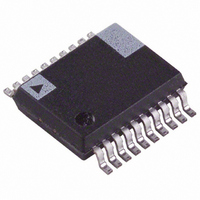ADE7761ARS-REF Analog Devices Inc, ADE7761ARS-REF Datasheet - Page 18

ADE7761ARS-REF
Manufacturer Part Number
ADE7761ARS-REF
Description
IC ENERGY METERING 20-SSOP
Manufacturer
Analog Devices Inc
Datasheet
1.ADE7761ARS-REF.pdf
(28 pages)
Specifications of ADE7761ARS-REF
Rohs Status
RoHS non-compliant
ADE7761
DIGITAL-TO-FREQUENCY CONVERSION
As previously described, the digital output of the low-pass filter
after multiplication contains the active power information.
However, because this LPF is not an ideal “brick wall” filter
implementation, the output signal also contains attenuated
components at the line frequency and its harmonics, that is,
cos(hωt), where h = 1, 2, 3, …, and so on. The magnitude
response of the filter is given by
For a line frequency of 50 Hz, this gives an attenuation of the 2ω
(100 Hz) component of approximately –26.9 dB. The dominat-
ing harmonic is at twice the line frequency, cos(2ωt), due to the
instantaneous power signal.
Figure 25 shows the instantaneous active power signal output of
the LPF, which still contains a significant amount of instantane-
ous power information, cos(2ωt). This signal is then passed to
the digital-to-frequency converter, where it is integrated
(accumulated) over time to produce an output frequency. This
accumulation of the signal suppresses or averages out any non-
dc components in the instantaneous active power signal. The
average value of a sinusoidal signal is zero. Therefore, the
frequency generated by the ADE7761 is proportional to the
average active power.
Figure 25 also shows the digital-to-frequency conversion for
steady load conditions: constant voltage and current. As can be
seen in Figure 25, the frequency output CF varies over time,
even under steady load conditions. This frequency variation is
primarily due to the cos(2ωt) component in the instantaneous
active power signal.
MULTIPLIER
INSTANTANEOUS ACTIVE POWER SIGNAL (FREQUENCY DOMAIN)
0
H
V
I
(
LPF TO EXTRACT
ACTIVE POWER
(DC TERM)
f
)
ϖ
FREQUENCY (Rad/s)
=
Figure 25. Active Power to Frequency Conversion
1
2ϖ
=
(
LPF
f
4 /
1
5 .
Hz
)
FREQUENCY
FREQUENCY
DIGITAL-TO-
DIGITAL-TO-
2
F1
F2
CF
FOUT
F1
TIME
TIME
Rev. A | Page 18 of 28
(6)
The output frequency on CF can be up to 2048 times higher
than the frequency on F1 and F2. This higher output frequency
is generated by accumulating the instantaneous active power
signal over a much shorter time while converting it to a
frequency. This shorter accumulation period means less
averaging of the cos(2ωt) component. As a consequence, some
of this instantaneous power signal passes through the digital-to-
frequency conversion. This is not a problem in the application.
Where CF is used for calibration purposes, the frequency
should be averaged by the frequency counter, which removes
any ripple. If CF is being used to measure energy, such as in a
microprocessor-based application, the CF output should also be
averaged to calculate power. Because the outputs F1 and F2
operate at a much lower frequency, a lot more averaging of the
instantaneous active power signal is carried out. The result is a
greatly attenuated sinusoidal content and a virtually ripple-free
frequency output.
TRANSFER FUNCTION
Frequency Outputs F1 and F2
The ADE7761 calculates the product of two voltage signals (on
Channel 1 and Channel 2) and then low-pass filters this product
to extract active power information. This active power infor-
mation is then converted to a frequency. The frequency
information is output on F1 and F2 in the form of active high
pulses. The pulse rate at these outputs is relatively low, for
example, 0.34 Hz maximum for ac signals with S0 = S1 = 0 (see
Table 7). This means that the frequency at these outputs is
generated from active power information accumulated over a
relatively long period of time. The result is an output frequency
that is proportional to the average active power. The averaging
of the active power signal is implicit to the digital-to-frequency
conversion. The output frequency or pulse rate is related to the
input voltage signals by the following equation:
where:
F
V1
V2
V
F
logic inputs S0 and S1 (see Table 5).
1
1–4
REF
− F
rms
rms
is one of four possible frequencies selected by using the
is the reference voltage (2.5 V ± 8%) (V).
F
is the differential rms voltage signal on Channel 1 (V).
is the differential rms voltage signal on Channel 2 (V).
1
2
−
Frequency is the output frequency on F1 and F2 (Hz).
F
2
Frequency
=
. 5
70
×
V
1
rms
V
REF
×
V
2
2
rms
×
F
1
−
4
(7)












